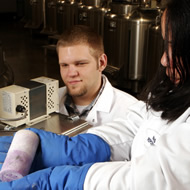
Environmental Factor, October 2008, National Institute of Environmental Health Sciences
High Levels of Pesticides and Endocrine Disruptors in Pregnant Women in the Netherlands
By Dixie-Ann Sawin
October 2008


In an NIEHS-led study published online September 4 in the journal Environmental Research, a team of American and European researchers reported finding high levels of organophosphorous (OP) pesticides and some suspected endocrine disrupting compounds including bisphenol A (BPA) and phthalates, in pregnant women and their offspring in the Generation R Study in the Netherlands. The study is a population-based birth cohort study.
The investigators analyzed urine specimens of 100 pregnant women selected from the cohort and found relatively high levels of OP and some phthalates, but similar levels of BPA compared to data from studies of pregnant women elsewhere in the world. Because of the surprisingly high levels, as well as the birth outcome and follow-up information in the study of an environmentally exposed population, the researchers concluded that the Generation R study “provides an opportunity to efficiently address questions regarding the reproductive and development effects of prenatal exposures.”
The lead author of the paper, Postdoctoral Fellow Xibiao Ye, Ph.D., is a member of the NIEHS Biomarker-based Epidemiology Group, which is headed by co-author and Principal Investigator Matthew Longnecker, M.D., Sc.D. The Biomarker-based Epidemiology Group focuses on health effects of early exposure to background levels of environmental contaminants.
The study (http://www.ncbi.nlm.nih.gov/pubmed/18774129?ordinalpos=3&itool=EntrezSystem2.PEntrez.Pubmed.Pubmed_ResultsPanel.Pubmed_DefaultReportPanel.Pubmed_RVDocSum) ![]() builds upon growing concern about the impact of low-level exposures to these compounds in the general population and, particularly, among pregnant women. The extensive use of OP pesticides increases exposure for humans primarily through food. BPA is used in the manufacturing of plastics and epoxy resins, and human exposure comes from food in containers lined with BPA and from some dental sealants. Phthalates are commonly included in cosmetics and polyvinyl chloride plastics.
builds upon growing concern about the impact of low-level exposures to these compounds in the general population and, particularly, among pregnant women. The extensive use of OP pesticides increases exposure for humans primarily through food. BPA is used in the manufacturing of plastics and epoxy resins, and human exposure comes from food in containers lined with BPA and from some dental sealants. Phthalates are commonly included in cosmetics and polyvinyl chloride plastics.
Animal studies have shown that these pollutants can affect brain and reproductive development. The effects on the human population, however, are not clear.
The Generation R study, which includes 9778 participants, is led by scientists at Erasmus University. The study addresses four primary areas — growth and physical development, behavioral and cognitive development, childhood diseases and health, and health care for pregnant women and children.
The researchers analyzed the levels of 6 dialkyl phosphate (DAP) metabolites of OP pesticides, a specific metabolite of the widely used pesticide chloropyrifos, TCPy, BPA and fourteen phthalate metabolites in single urine samples from a subset of 100 of the Generation R pregnant women who were enrolled after February 2004 and had a live birth. They then compared the results to data on pregnant women in three US studies and studies from elsewhere in the world.
Their measurements indicated that the subjects from the Generation R study had higher-level exposure to OP pesticides and some phthalates, but BPA levels were similar to the populations in other studies. The choice of metabolites to study was based on the ability to compare to data from available studies. However, the investigators caution about the possible use of these as biomarkers of exposure because they can also reflect direct exposure to metabolites. They also state that it may be necessary to make additional measurements across the entire pregnancy in order to identify critical time periods of exposure.
This study is, nevertheless, the first report of biological monitoring of these specific pollutants in a general population in the Netherlands and can serve as a building block for further investigation of the effects of OP pesticides, BPA and phthalates on human health.
Citation: Ye X, Pierik FH, Hauser R, Duty S, Angerer J, Park MM, Burdorf A, Hofman A, Jaddoe VW, Mackenbach JP, Steegers EA, Tiemeier H, Longnecker MP. (http://www.ncbi.nlm.nih.gov/pubmed/18774129?ordinalpos=3&itool=EntrezSystem2.PEntrez.Pubmed.Pubmed_ResultsPanel.Pubmed_DefaultReportPanel.Pubmed_RVDocSum) ![]() 2008. Urinary metabolite concentrations of organophosphorous pesticides, bisphenol A, and phthalates among pregnant women in Rotterdam, the Netherlands: The Generation R study. Environ Res [Epub ahead of print].
2008. Urinary metabolite concentrations of organophosphorous pesticides, bisphenol A, and phthalates among pregnant women in Rotterdam, the Netherlands: The Generation R study. Environ Res [Epub ahead of print].
(Dixie-Ann Sawin, Ph.D., is a postdoctoral research fellow in the Laboratory of Neurobiology/Neurotoxicology Group.)
"Meeting Explores Genetic..." - previous story ![]()
![]() next story - "NTP Holds Meeting..."
next story - "NTP Holds Meeting..."
October 2008 Cover Page



